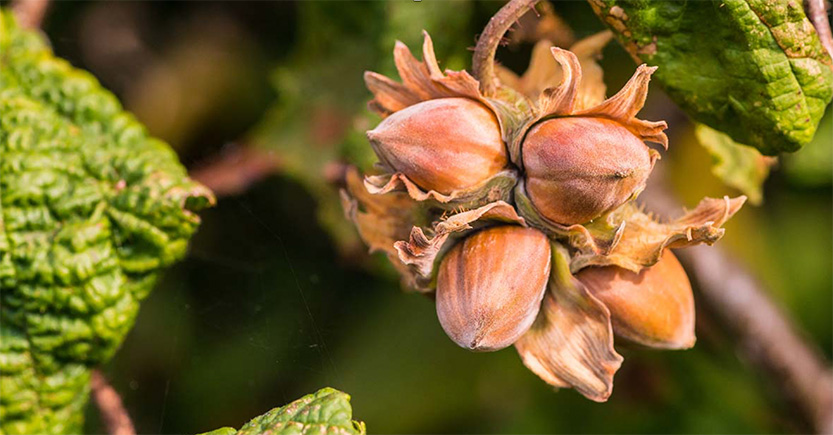Hazelnut
Hazelnut is a versatile shrub with many landscape, wildlife and human uses.
Scientific Name: Corylus americana
Common Name: American Hazelnut
Plant Family: Betulaceae (Birch family)
Etymology: The genus name, Corylus, comes from the Greek korylos, meaning helmet, and refers to the husk on the nut. Americana comes from the plant’s native region.
Indigenous Uses
Many indigenous tribes including the Cherokee, Chippewa, Dakota, Iroquois and many others used hazelnut for a variety of uses. Hazelnut was used as food in a variety of dishes, including soup, bread, and corn pudding. Nuts were also eaten raw, either alone or with honey, and stored as food for winter. The Iroquois also crushed fresh nut meats and boiled for use as a drink. Some other uses for hazelnut included as a black dye, oftentimes mixed with butternut, to make drumming sticks, and the twigs were used for baskets and broom making. The Iroquois tribe mixed the oil with bear grease and used the mixture to keep mosquitos away.
Hazelnut also had a variety of medical uses. One common use was to use the inner bark to induce vomiting. An infusion of the branches and leaves was also used as a gastrointestinal aid for intestinal disorders. Children were given a decoction of bark to help with teething, and stems were used to make necklaces that also helped with teething. The bark could be used to help heal cuts and for eye pain. It was taken as and antihemorrhagic and for prenatal strength and had a variety of other uses as well.
Edible Parts
The nuts are edible and can be used raw or cooked in many dishes including ground up and used as flour for bread, biscuits and sweets or in soups and stir fry. They can also be eaten raw or toasted in pasta or on a salad. Generally, nuts are sweetest before they are fully ripe, at the milk stage.
Gathering and Using
Hazelnuts can be gathered after they fall from the tree. Branches can also be lightly shaken to help more nuts drop. It is best to gather fallen nuts before autumn rains begin.
After nuts have been removed from the shell, they can be pulsed in a blender until finely ground into a flour. Make sure to not allow the hazelnuts to heat up, as you may accidentally produce hazelnut butter by allowing the oils to release. If hazelnut butter is desired, roast hazelnuts for 12-15 minutes and then immediately blend.
Dried, shelled seeds can be stored in a cool dry place for up to a year, or shells can be removed before drying and nuts can be stored in the fridge or freezer.
Permaculture Functions and Considerations
Wildlife food and habitat, human food, windbreaker, juglone resistant (can be planted between walnut trees and other plants), does well with nitrogen fixers, agroforestry, pleasing landscaping
Habitat
Native across the eastern half of the United States and Canada, it is often found in the border of woodlands, or even inside woodlands. It can also occur in prairies, and once formed large thickets in savannahs.
How to Identify
Hazelnut is a shrub that grows 10-16 feet in height. It has heart-shaped leaves with toothed edges, which appear in alternating patterns on branches. Leaves are hairy beneath and are paler on the back than the front. The nut is acorn-like and enclosed in a husk-like, leafy bract.

https://gardenerspath.com/plants/nut-trees/grow-hazelnut/
Wildlife Support
Nuts are eaten by birds including pheasants, grouse, and turkey, as well as deer, squirrels and other animals. Songbirds and small mammals will also nest in the plant.
Additional Information
Hazelnut can be susceptible to Eastern Filbert Blight, as well as leaf spots, blight, and crown gall.
Can be propagated using either seeds or softwood cuttings, although cuttings may be unsuccessful.
Most commercial production of hazelnuts use the European variety (Corylus avellane), but native American variety will likely survive harsh winters and American plant diseases better. The American variety does have slightly smaller nuts than the European variety.
Sources
- American hazelnut. (n.d.) USDA Department of Agricultural Natural Resources Conservation Service.
- American hazelnut. (n.d.). USDA Plants Database.
- American hazelnut tree. (n.d.). Arbor Day Foundation. Retrieved March 7, 2022,
- Corylus americana. (n.d.). Missouri Botanical Garden. Retrieved March 7, 2022.
- Corylus americana. (n.d.). Lady Bird Johnson Wildflower Center - The University of Texas at Austin. Retrieved March 7, 2022.
- Corylus americana. (n.d.). USDA Plants Database. Retrieved March 7, 2022.
- Corylus americana american hazel. (n.d.). PFAF Plant Database. Retrieved March 7, 2022.
- Harper, E. (2020, September 21). Edible (native) landscaping – american hazelnut. The Land Connection. Retrieved March 7, 2022.
- Hazelnut. (n.d.). BRIT - Native American Ethnobotany Database. Retrieved March 7, 2022.
- Thornbro, H. (n.d.). Growing hazelnut in your permaculture food forest: A complete guide. Redemption Permaculture. Retrieved March 7, 2022.
- Olsen J., Raab, C. (1968, April). Harvesting, handling, and storing nuts from the home orchard. Oregon Sate University Extensions Service.